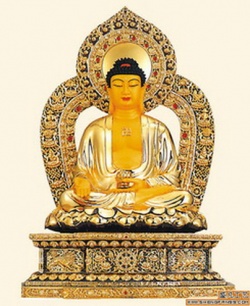China: Pure Land by Arnie Kozak, Ph.D
The other main school of Buddhism to start in China around the same time was called Pure land. This school of Buddhism, unlike Bodhidharma's Chan, did believe in a system of merits and also promoted the idea that there is more than one Buddha.
They also believe that this realm has many different fields, the best being that of paradise, or Pure land. A purified field surrounds Buddhas and Bodhisattvas. The belief contends that out of their great Compassion they create a space around them that is uncontaminated. This space is available for those who wish to join them. It is attributed to Amitabha Buddha (The Buddha of Infinite Light). Amitabha is known as Amituo Fo in China and Amida Butsu in Japan. The Pure land is also known as Sukhavati (“Abode of Bliss”).
Pure land Buddhists believe in a paradise after Death. Amitabha, The Buddha of Infinite Light, is host there. If you invoke the name of Amitabha (Namo Amituo Fo), you will be reborn into the Pure land. Pure land in your Mind is the place where Enlightenment takes place; it is not Enlightenment itself.
Therefore, in Pure Land Buddhism, if you invoke the name of The Buddha, you invoke the reality of Pure land. This practice was less rigorous than the Chan practice and found widespread acceptability. One could be reborn into a paradise here at any time. All you had to do was recite The Buddha's name over and over, and paradise is yours. There were no impediments to Enlightenment once you attained Pure land, so much of the work of practice was alleviated.
The Jingtu Lun is an important Pure land text that outlines five forms of devotion:
- Expressing reverence for Amitabha Buddha
- Praising Amitabha's Virtue by reciting his name
- Spoken aspirations to be born in the Pure land
- Contemplation on the physical Form of Amitabha, Bodhisattvas who live in the Pure land, and the Pure land itself
- Transferring one's own Merit to assist others in reaching the Pure land
According to Buddhist scholar Michael Willis, “The Pure land is described as a kind of paradise devoid of diversion, such as women and conflict, and superior to any Heaven because Amituo resides there, prepared to preach the Dharma to all those who ask for assistance.”
The Pure land practice is comparable to the Bodhisattva Path, and its advocate Daochuo (562–645 C.E.) argued that it would be more expedient in this degenerate age because Amitabha was there to help. The Pure land Path was easier too, and therefore more accessible to common people. Pure Land Buddhism is popular in the West today.
